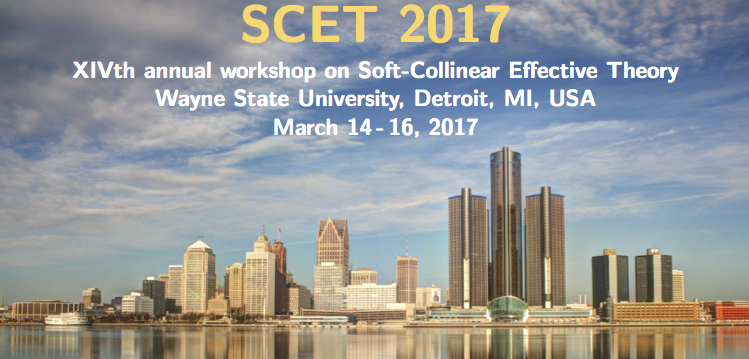We review the treatment of inclusive small radius jets and their substructure within Soft Collinear Effective Theory (SCET). The cross section for (semi-) inclusive jet observables can be written in a factorized form in terms of hard functions and so-called semi-inclusive jet functions (siJFs). The siJFs satisfy renormalization group (RG) equations which take the form of standard timelike...
We introduce the jet fragmentation function (JFF) to describe the fragmentation of a parton into a jet, and discuss how these objects are related to the standard jet functions. Calculating the JFF to next-to-leading order, we show that these objects satisfy the standard DGLAP evolution equations, with a natural scale that depends upon $R$. By using standard renormalization group evolution, we...
We show how the top mass can be extracted kinematically using cross sections for event shapes observables calculated using effective field theory methods. With the help of Soft Drop grooming done at a level that does not disturb the radiation that can modify the top mass definition, while still isolating the top jet, we obtain a distribution that is only mildly sensitive to the underlying...
The lack of knowledge how the top quark mass parameter in Monte-Carlo event generators (MC) is related to field theoretically well defined mass schemes limits the theoretical interpretation of the most precise top quark mass measurements. At SCET2016 preliminary results for the calibration of Pythia's top quark mass parameter using an effective field theory approach for 2-jettiness were...
Homogeneous power counting in Non-Relativistic QCD with the velocity renormalization group (vNRQCD) necessitates the existence of both soft and ultrasoft gluons. We show that vNRQCD operators involving soft fields can be put in a manifestly gauge invariant form by exploiting gauge invariant gluon building blocks. These building blocks contain Wilson lines and are analogous to those used in...
In this talk I will discuss how ideas from SCET can be utilized in the
context of Fermi liquids. In particular I will discuss the case of the Hubbard model at half filling where the presence of singular points on the Fermi surface force the EFT to be modal with soft and collinear IR fields.
We study the transverse momentum spectrum of hadrons in jets. By measuring the transverse momentum with respect to a judiciously chosen axis, we find that this observable is insensitive to (the recoil of) soft radiation. For small transverse momenta we show that the effects of the jet boundary factorize, leading to a new transverse-momentum-dependent (TMD) fragmentation function. In contrast...
The factorization theorem for DY and semi-inclusive DIS holds for all leading twist transverse momentum distributions. However a QCD perturbative calculation shows several important characteristics of spin-dependent distributions. We consider the case of Helicity and Transversity, which are the only spin-dependent distributions which can be matched onto integrated twist-2 functions. We...
I will discuss how the evolution of parton distribution functions are affected at very high energies due to logarithmically enhanced terms originating from electroweak symmetry breaking
We will present the final pieces for our automated strategy to evaluate
generic dijet soft functions at 2-loop order: the Cf^2 colour structure,
enabling us to compute observables breaking non-abelian exponentiation. In
the process, we will highlight the problems unique to this colour
structure, give results for a few sample observables and show explicit
analytic formulae for NNLL resummation...
We calculate the momentum sharing and angular separation distributions between the leading subjets inside a reconstructed jet, as well as the jet mass distribution modification in heavy ion collisions. These observables are sensitive to the early and late stages of the in-medium parton shower evolution and allow us to probe the quark-gluon plasma across a wide range of energy scales. We use...
We study the transverse momentum spectra of gauge bosons ( Z, $\gamma^*$, Higgs) in PP collisions in the regime of low transverse momentum. We develop a scheme of resummation allowing us to choose the factorization scale for virtuality in momentum space which is then applied to obtain the transverse momentum spectra for the Drell-Yan and Higgs at NNLL accuracy. All the schemes of resummation...
In the study of heavy color-singlet production one often encounters large logarithms involving the threshold parameter in the partonic cross-section which need to be resummed. Considering the transverse momentum distributions of such processes leads to additional large logarithms involving pT. In this talk a method of doing the simultaneous resummation of both types of logarithms directly in...
We present a framework for resumming logarithms of the jet veto $\ln p_T^\text{cut}/Q$
in color-singlet production at forward rapidities,
where approaching the "lopsided threshold" $Y \to Y_\text{max}$ imposes additional constraints on the modes present in the usual $p_T^\text{jet}$ factorization.
We discuss the relevant regimes and factorization theorems
and show how to consistently...
We present a complete basis of power suppressed operators for $gg \to H$, classifying all operators which contribute to the amplitude at $\mathcal{O}(\lambda^2)$ and identifying the subset of operators which contribute in the cross section at this order. We show how helicity selection rules significantly simplify the construction of the operator basis. We perform matching calculations to...
From a detailed analysis of cone-jet cross sections in effective field theory, we obtain novel factorization theorems which separate the physics associated with different energy scales present in such processes. The relevant low-energy physics is encoded in Wilson lines along the directions of the energetic particles inside the jets. This multi-Wilson-line structure is present even for...
Many collider observables suffer from non-global logarithms not captured by standard resummation techniques. Classic examples are the light-jet mass event shape in the limit of small mass and the related hemisphere soft function. We derive factorization formulas for both of these and explicitly demonstrate that they capture all logarithms present at NNLO. These formulas achieve full scale...
I describe the systematic treatment of QED radiative corrections for lepton-nucleon scattering. These corrections are critical for the long baseline neutrino program (quasi elastic neutrino scattering) and for the determination of fundamental constants and the elucidation of the proton radius puzzle (elastic electron-proton scattering).
